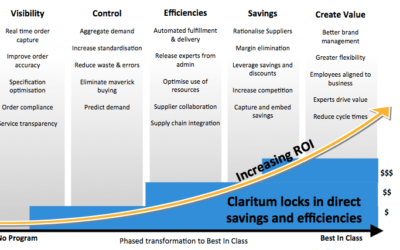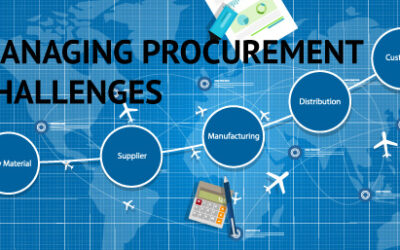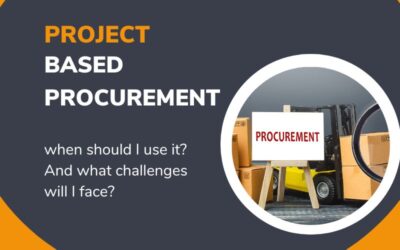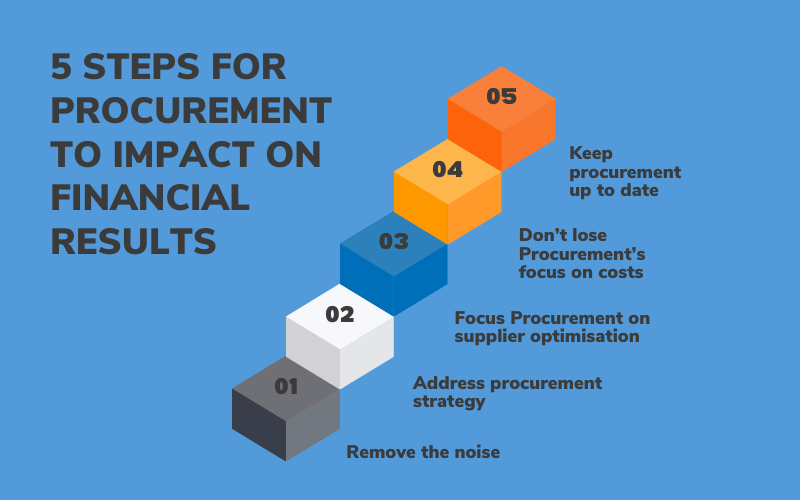
Introduction
Procurement is a complex multidisciplinary team activity that crosses all areas of the business. The variables and complexities of purchasing products and services, from basic supplies through to strategic purchases, make Procurement a key resource within the business.
In addition, there are distinct specialist areas that are unique to the procurement function. Including governance and adherence to relevant social responsibility policies: procurement are the experts in these domains.
The procurement environment is dynamic and constantly changing with many influences: political, environmental and technological. With Procurement behind the drive for sustainable/ethical supply of goods and services to efficiently and effectively support the operations of the organisation.
Within this environment, the Procurement has to remain focused on maximising financial results associated with the supply and use of goods and services. It is procurement at the heart of any impact on P&L. Financial management within Procurement is therefore of critical importance.
The Hackett Group summarises this well:
“The leadership and management challenges to create awareness, get support, and galvanize all the necessary stakeholders required to shape a winning team for this multi-disciplined sport of procurement are daunting. But the aggregate value potential is worthy of the effort…
… procurement transformation is not about getting to the lowest cost of procurement; it is about maximizing financial results.”
So, what needs to be done to enable procurement to have the maximum impact possible on your financial results.
1. Remove the noise
The first and most important step is to move Procurement away from being a transactional based function.Focused purely on moving purchase transactions though the organisation.
Value will never be realised If Procurement continues to function as an order processing organisation.
However, taking the traditional approach to automate procurement is not the answer. Introducing technology that is focused on automating what the Procurement function does is not the way forward. It is a very short-sighted view of what is required to move Procurement away from a transactional environment.
The focus should not be on automating procurement.
The focus should be on automating the buying process from a user/departmental perspective. The user needs to focus on the specific details of any purchase: if procurement is involved, in a direct line in the process, this will be a very inefficient purchase process. Certainly wasting procurement time in irrelevant details.
This automation can be achieved with either the right investment in eProcurement technology (platforms that enable users to buy goods and services without involving procurement people.) Or it can be achieved through outsourcing a significant proportion of the Indirect spend activity to an automated outsourcing company.
The key, whether insourcing or outsourcing, is to ensure that you are enabling the end users to get exactly what they need quickly, easily, and in compliance with procurement policy. Without them having to understand the intricacies of that policy.
Procurement should not be concerned with the buying and receiving transactions.
These need to be automated and the primary concern of the departments with the need for the products or services.
It should be noted that, excluding Strategic Spend, over 60% of purchase transactions made are repeated, either with exactly the same specification or with minor changes to specification. Why would or should Procurement be involved in these transactions?
The Procurement team need only to be able to monitor and report as needed on the flow of purchasing transactions. Ensuring that policies are adhered to and that there is appropriate supplier selection (strategic suppliers, approved suppliers and competitive bids for example.)
The following diagram shows the relationships that should exist between suppliers, users and Category Managers.
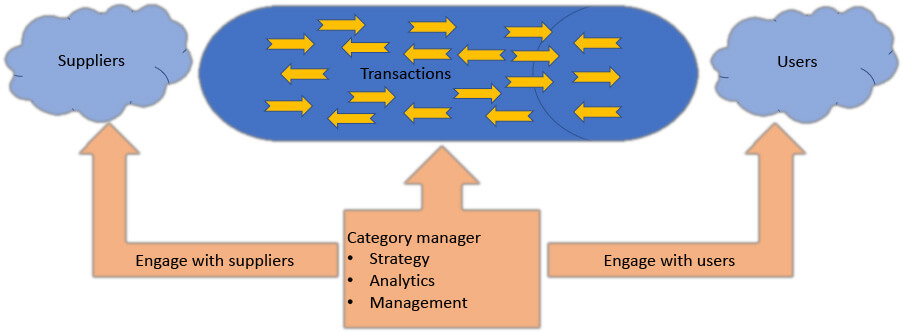
Later in this article we will cover the areas that Procurement, with the noise removed, is now able to focus on.
Step 2. Address procurment strategy
This step follows the initial step, to remove the noise, since it is impossible to strategize if day to day procurement transactions are interrupting this process.
Having removed the noise, you can now place the Procurement team’s emphasis on strategic activities. Rather than transactional or compliance-focused activities.
Placing the emphasis on procurement initiatives that correlate with the strategic goals of the organization. Ensuring that there is an overall benefit across the organisation in terms of financial performance.
According to the Hackett Group’s analysis of its procurement benchmarking database, world-class procurement organizations have a larger percentage of their staff allocated to sourcing, supply base strategy, and planning/strategic roles, while others are more focused on operations and compliance management.
So, what strategic areas should you focus on?
The focus on strategy means that your Procurement team is now operating in a command and control role, as opposed to service role. The areas that they focus on will to some extent depend on the nature of your business, however there are some common areas of strategic focus and development of plans:
- Analysing and quantifying value chains
- Supply chain optimisation
- Securing competitive suppliers for Indirect Spend categories
- Risk management and governance
- Building strategic relationships
- Innovation, encouraging suppliers to put forward their own innovations
- Optimising organisational processes and driving improvements
- Managing money well. E.g. payments or organisational efficiencies
- Defining best practice across the entirety of the supply chain
- Addressing ethical business and supply chain practices
What don’t they focus on?
Getting the Procurement department’s work done:
It is not about the Procurement function. It is about the wider organisation, within which they are a key player. Yes, Procurement’s work will get done, however this will be in context of the wider organisational benefit and P&L impact.
Step 3. Focus Procurement on supplier optimisation
This is focusing on the supplier optimisation, not focusing on the order/s associated with the supplier (the transaction/s).
Most articles focus on supplier relationship management, as the most important aspect to optimise the supply chain. Rather than repeat the many articles written on this topic, let’s for a moment assume that we are already well advanced on developing supplier relationships.
So, job done then. No. The key is to focus on how to optimise the supply value chain. Engaging with the suppliers to propose ways that this can be achieved. Let them do the work to be a more efficient and effective supplier. What can they do to impact:
- lead times
- costs (or make you more profitable)
- social responsibility factors
- returns
- risk
- cashflow
In addition, of course, the Procurement teams’ function is to ensure that the ongoing supplier relationship remains strong. That policies are adhered to and that suppliers are appropriately selected. With the associated terms and conditions tied down.
However, individuals in the Procurement function cannot be the experts on all aspects. They can, though, be the expert on how the organisation is affected by supply in their specific Category. Having a true understanding of the end to end impact of their Category of products or services within their organisation (the value chain.)
Step 4. Don’t lose Procurement’s focus on costs
It is important, when shifting the focus of Procurement from transactional behaviour, that the core delivery on cost savings and the focus on P&L is not lost.
Procurement has always had a significant and very important role in managing costs across the organisation. Any procurement initiative should:
- reduce the cost of doing business compared to the previous financial year
and impact directly on the P&L. - Avoid inflationary direct costs for each category, as well as any associated increase in costs across the business.
Payment terms, Inventory and capital spend are also key areas for focus. However again an overall impact on business and risk analysis is essential: for example, if reduction in inventory results in sporadic out of stock events then the cost associated with this may far outweigh any benefit.
Procurement needs to deliver on cost savings across the organisation
This is wider than the purchase value of the product and service. For example, it may be that changing the way goods are supplied or packaged has a huge impact on overall organisational costs.
It is also not sufficient to just to include contract terms or pricing schedules. It is essential to ensure that the business benefits from these: what is the point of agreeing price breaks if these are never actually implemented, because the organisation is not aware that they have exceeded a volume threshold?
The point is, that in every sourcing decision there are a number of relevant factors, of which price is just one.
The focus on P&L across the organization is key to any purchase. If paying a higher price for an item results in reduced overall costs then this is a good purchase decision. The Procurement function should not be penalised for an increased cost if this results in an overall positive impact on P&L.
Taking account of all factors across the organisation is key and quantifying them in terms of their cost impact or revenue generation essential.
There is no excuse. You can quantify the impact of any change.
All things can be quantified in terms of their impact on the bottom line of an organisation.Procurement’s responsibility is to ensure this is done. Plus, ensure that the savings are actually realised.
Whatever a stakeholder, in your supply chain or organisation, brings to the table you must ensure it is reflected in monetary terms. You can quantify risks, innovations and supplier preferences.
The Procurement team should be held to account to show numerical impacts.
Do not allow softer factors to be used as a reason for change, unless their impact on your bottom line has been quantified.
Procurement have historically only measured cash releasing savings. Now they need to quantify and track many other aspects associated with the value chain of their purchased products and services.
Spend coverage
One of the reasons cited for poor performance in Procurement’s control of costs is their Spend Coverage.
“Leading procurement organizations have up to 67 percent more reach and influence over their organization’s spend than average performers” Assessment of Excellence in Procurement (AEP) research
Events, negotiations and results need to be actively tracked in order to be able to identify best approaches and develop ongoing strategies across all categories of spend. It is essential to gain insight and visibility into detailed spend information to be able to identify opportunities to improve.
Extent of control / visibility
Procurement’s involvement needs to extend to all domains of spend, to ensure competitive supply arrangements and get the best value from products and services.
Procurement needs to develop strategies for strategic purchases, commodity items and one-off purchases. Whatever the spend domain a strategy to achieve best results needs to be developed and maintained.
This now, for example, even includes salaries: with the increasing use of temporary resources, consultancies and a contract workforce, Procurement can significantly impact on value derived from the workforce. Whether this is in terms of direct cost to the business or effectiveness of these resources, Procurement has a role to play.
5: Keep procurement up to date
Don’t underestimate how important it is to train the Procurement team and constantly review the skills necessary. This is a changing and dynamic world and Procurement has to keep up to date if they are going to impact on P&L.
Whether it is legal, environmental or technological change it will all impact on your business. Procurement is in a unique position to ensure change has the maximum financial impact. It is therefore obvious that they need to be aware of both internal and external changes and plans in order to be effective.
Internal change
For example, looking at an internal change: let’s take a simple decision made by a marketing department to move to using only electronic distribution of brochures. Prior knowledge would enable Procurement to manage the current paper-based suppliers, as volumes dramatically fall ensuring that costs do not significantly rise. Plus, it would enable procurement to engage with potential suppliers of the electronic systems software to ensure that the most beneficial supply arrangement is achieved.
External change
An external factor example could be the changing landscape associated with Social Responsibility legislation and how this might impact on supply chains. As the emphasis is increasingly placed on organisations to know more about the origins of the products and services they are purchasing, it might be more beneficial to source only from certain regions or countries. Or, if purchasing from regions of higher risk of non-compliance, there may be additional costs to factor into the business decision associated with effective monitoring and risk mitigation associated with these suppliers in these regions/countries.
The key point to remember is that organisational changes and change within the operational environment of the organisation all have an impact on procured goods and services. Procurement is a key resource for assessing the impact of change and managing the impact on P&L associated with supply of goods and services.
Summary
This article covered five key aspects on how your Procurement team can be moved towards having maximum impact on your financial results.
The key steps identified in this process were:
- Remove the noise
- Address Procurement strategy
- Focus Procurement on supplier optimisation
- Don’t lose Procurement’s focus on costs
- Keep Procurement up to date
Impacting on all five of these areas will ensure that your procurement is more effective and that you will see P&L impact from the investment you are making in Procurement as a function.
If your Procurement team remains as a transactional resource, then you are missing significant and sustainable impact on your P&L.
If you would like to discuss any aspect of this article, then please feel free to contact us
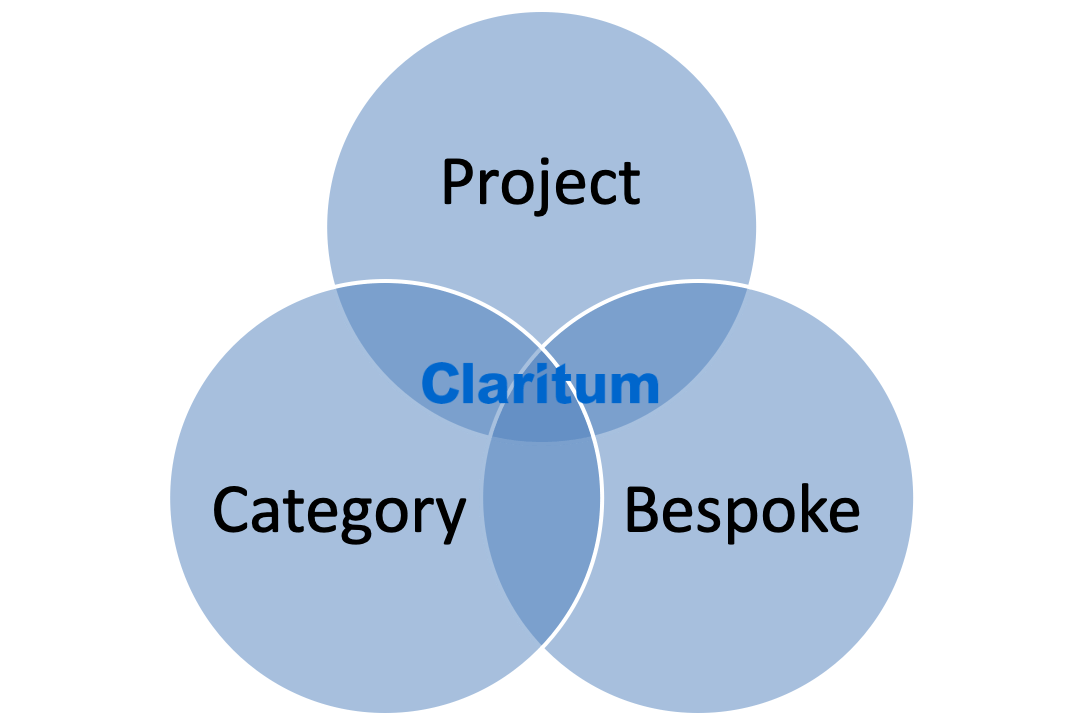
7: Characteristics of good Project Procurement activity
Companies that consistently capture the most value from project procurement typically have these critical procurement capabilities:
- Superior supply-market expertise for procurement of project-based goods and services
- Project based automation for Sourcing through to Payment
- Early assessment of project-related procurement risks
- A cross-project sourcing focus to gain from common project activity
- A focus on TCO associated with all purchases within the project and for the overall project
- Use of RFQs and Contractual terms that are designed to optimise supply performance against the project objectives

